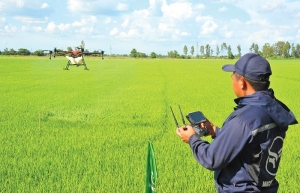The top pitfalls and prospects of 5G development
This dramatic increase in speed and connectivity is a boon to innovation, enabling the development of new products and services, and spurring economic growth and activity.
 |
| Philip Ziter - Senior associate Russin & Vecchi |
Along with innovation and new developments, 5G will enhance and enable critical services and management of important resources. Precision agriculture, construction and mining, digitalised education, connected healthcare, smart manufacturing, intelligent retail, and connected smart cities are areas where development will be catalysed and enabled by 5G coverage.
Security of data on 5G communications infrastructure – that is, data and information that is transmitted and stored on it – is a key security interest of national significance. The security of 5G networks, as it relates to equipment or software, including any part of the network, is of critical importance.
Thus, great care is placed on avoiding the implementation of products developed, manufactured, or supplied by companies under the control or influence of a foreign government whose national security interests are perhaps not aligned with those of Vietnam.
By virtue of its high capacity and ultra-low latency, 5G will enable meaningful adoption of AI-enabled technologies and applications through the Internet of Things (IoT) across a range of sectors. As enterprises employ 5G to process and analyse increasingly greater volumes of data, and as businesses become better equipped to monetise these huge volumes of data, revenues and valuations are expected to increase.
Digital transformation is viewed as a key factor in boosting the economy and fostering sustainable development. 5G enables initiatives aimed at improving smart water use, innovative energy inventory and management for large buildings, smart traffic management technology, and remote sensors that compile air quality data.
For example, reducing vehicle emissions with the use of intelligent traffic signal control systems has been shown to lead to up to 20 per cent lower emissions. Radar and cameras are used to respond to traffic conditions as they change in real time. The result is that vehicles spend significantly less time stopping or idling at intersections, leading to significant reductions in emissions.
Smart water monitoring for agricultural applications – tracking rainfall, plants’ water requirements, sun exposure, and weather predictions – rely on precise measurements enabled by 5G-powered devices. While this technology already exists, 5G promises to make it more efficient and accessible.
Private 5G networks have the potential to revolutionise container ports, warehousing and logistics, airports, hospitals, hospitality, manufacturing, farming and more.
In the healthcare context, for example, doctors and patients will be more connected than ever. For example, an internal defibrillator could automatically alert emergency room cardiologists of a patient experiencing symptoms, allowing physicians to prepare for the incoming patient – complete with a full record of data collected by the device.
Data will fuel the growth of most sectors, and agriculture is no exception. Farms will continue to consume more data, resulting in the need for fewer chemicals. Sensors installed directly in fields, allow farmers to identify, with incredible precision, which areas require additional water, pest management, or show signs of invasive disease.
As economies of scale and manufacturing efficiencies make wearable technology more affordable, 5G enables networks with large numbers of IoT devices. For example, farmers can use health monitoring devices for livestock, gaining much more accurate and timely health data. This allows for significant reductions in the use of antibiotics, without risking the safety of food supply chains.
Meanwhile, in logistics and shipping, 5G allows greater communication between vehicles of a fleet. Vehicles can also communicate with infrastructure along the route. Navigation and monitoring of vehicles will improve with 5G, resulting in better route planning, shorter delivery times, and lower instances of driver error and accidents. AR systems used to identify potential hazards, without diverting a driver’s attention away from the road, could be employed and powered by 5G.
There are challenges, of course, and there are policy recommendations out there. As technology advances, legal developments often lag. Recent and impending changes to Vietnam’s data protection law have the potential to restrict the free flow of data.
The implications of data-intensive technologies powered by 5G are yet to be seen. A clear legal framework is needed to bolster investor confidence and drive innovation.
 | Localities focus on digital overhaul to boost trade A series of cities and provinces up and down Vietnam are rushing to accelerate digital transformation in order to increase business and trade facilitation. |
 | 4G/5G wireless networks driving digitalisation across industries People are seeing a massive digitalisation wave taking place across industries with reliable and secure connectivity serving as the foundation. |
What the stars mean:
★ Poor ★ ★ Promising ★★★ Good ★★★★ Very good ★★★★★ Exceptional
 Tag:
Tag:
Themes: Digital Transformation
Related Contents
Latest News
More News
- First members of Danang International Finance Centre revealed (December 22, 2025 | 17:39)
- Human-centred governance seen as key to AI development (December 19, 2025 | 18:19)
- Top 10 notable events of Vietnam’s industry and trade sector in 2025 (December 19, 2025 | 14:00)
- Tungsten surges to 12-year high as world enters a new 'black gold' race (December 18, 2025 | 17:27)
- Vietnam’s coffee exports set new record despite price pressures (December 18, 2025 | 17:13)
- Garment and textile sector seeks new growth after volatile year (December 18, 2025 | 17:01)
- VinSpeed and Siemens strengthen cooperation for high-speed rail development (December 18, 2025 | 16:53)
- High-tech adoption for TH true MILK (December 18, 2025 | 13:39)
- Takeda supports health resilience amid climate change challenges (December 18, 2025 | 12:39)
- Mondelez Kinh Do - a chapter of purpose-led leadership in Vietnam (December 18, 2025 | 09:44)
























 Mobile Version
Mobile Version